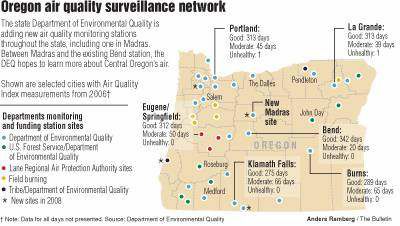To better measure region’s air quality, DEQ to add testing station in Madras
Published 4:00 am Thursday, March 6, 2008

- To better measure region’s air quality, DEQ to add testing station in Madras
As part of a statewide effort to expand the number of air monitoring stations, the Department of Environmental Quality wants to find out how the air quality in Bend compares with 40-some miles up the road in Madras.
Right now, air quality data for all of Central Oregon comes from an existing monitoring station in Bend. And as Mark Hansen, a senior air monitoring specialist for the DEQ, pointed out, the air in Madras, which is more rural and has more agricultural-related field burning than Bend, could be quite different.
“We don’t know a whole bunch about Central Oregon air quality,” Hansen said. “We kind of assume that Redmond and Madras reflect the air quality from Bend, but we’re not really sure.”
As Madras, population 6,500, continues to grow, it could be the ideal place to start testing for small particulate matter that can lodge in the lungs and potentially pose health risks to the public.
Officials are hoping to create a baseline level of data over a period of three years, so as the population increases they can compare it with any increases or decreases in the particulate levels. Data will be collected daily, with real-time results posted on the DEQ’s Web site.
“We’ll notice and probably look for impact with range, grass and forest fires,” Hansen said. “We’re not looking to bust anyone, but people have a right to know what kind of air they are breathing.”
Kristi Fisher, the smoke management coordinator for Jefferson County, works with farmers and a meteorologist to find out when weather will be ideal for field burning, which usually takes place in from July to September.
Fisher looks for days when the smoke will rise up into the atmosphere and move away from the city, as opposed to being stagnant close to the city. She works closely with the DEQ and believes the station will be beneficial to the area.
“This will give us actual scientific evidence of what’s going on,” Fisher said. “If we’re making mistakes and we’re putting smoke in the air when we shouldn’t, we’ll start changing that. Any time you have a scientific tool, you can improve … Right now we look, we smell and I run around the county and say, ‘I’m not seeing any smoke.’”
Jefferson County Health Department Director Diane Seyl said she has received health-related complaints when the air in Madras becomes smokier than usual.
The particulates the station will be looking for are less than 2.5 microns in diameter.
“It’s the diameter of a piece of hair,” said Anthony Barnack, an ambient monitoring coordinator for the DEQ. “That’s how small, it’s tiny.”
Particulates are caused by a variety of sources, such as motor vehicles and wood-burning stoves. Since officials first started monitoring Bend’s air quality in the late 1990s, there has never been a cause for concern — results have always shown that Bend’s air is clean.
There are around 45 to 50 air monitoring centers across the state, and the department is trying to expand that number into the 60s. It costs $12,000 to $15,000 to build a site, according to Hansen, and the majority of the sites are paid for by the EPA. The 2007 Legislature reserved funds for the Madras site as well as a potential one in Redmond.
The DEQ collects the data and then compares it with EPA standards. If concentrations of particulates are over EPA limits, the DEQ is responsible for helping the city decrease the amount. The DEQ would help the city devise a plan that would cut back on pollutants and improve the area’s air.
The only cities in Oregon that have come close to exceeding EPA standards are Oakridge, Klamath Falls and Medford.
The Madras site will contain a shed full of the monitoring equipment. An instrument, based on the fact that particulates scatter light, draws in air that is hit by an optical beam. In effect, the instrument measures visibility.
There will also be a tower to measure wind data in order to get a sense of where the pollution is coming from and where it’s heading.
It’s important that the monitor is located in an open space and not constricted by trees or buildings, according to Hansen.
Jefferson County School Board members agreed to allow the DEQ to put the monitoring school district property. The board selected a site in the northeast corner of Madras Elementary School, a fenced area that was once an old pond site. The DEQ has air monitoring stations on school property at eight other locations statewide.
Brad Holliday, a school board member who works at Central Oregon Seed Inc., said board members thought the monitoring station bring a nice educational component. Students will be allowed to tour the stations.
He also thought Madras was a prime place for testing, because of the amount of agriculture burning and many residents use wood-burning stoves during the winter.
The DEQ has submitted a conditional use application for the permit to operate within the city. They should know the city’s answer in two to four weeks, Hansen said.
“Collectively these sites provide data with which to better characterize the overall condition of Oregon’s air quality,” Hansen said. “And in turn, you could see how Madras fits into the region and Oregon fits into the larger, national air quality. It’s like the piece of a puzzle.”






